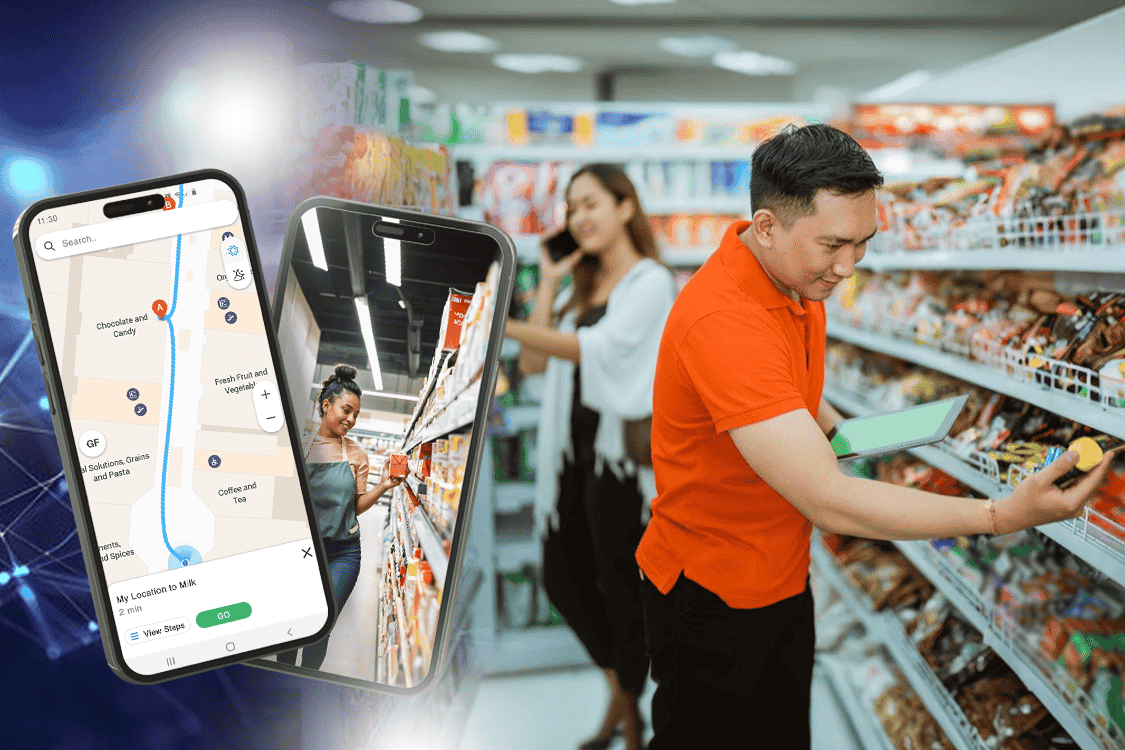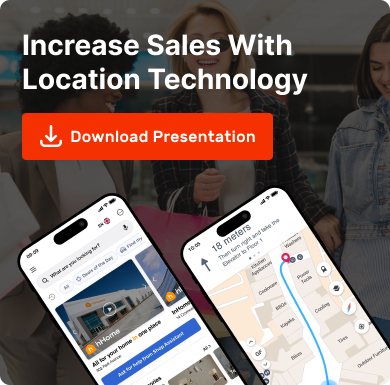Big Box Retail & Malls

Owning a retail property today is more than just renting out storefronts. Your success depends on foot traffic, tenant sales and the overall customer experience in retail. Empty stores and disengaged visitors don’t just hurt your bottom line—they drive down the appeal of your entire retail space. But there’s good news: retail spending is picking up again. The 2024 holiday season represents a $24 billion growth from the one before and nearly half of shoppers intend to shop at department and discount stores. That’s a sign that in-person shopping is bouncing back. Retail property owners who embrace location-based services (LBS) will be the ones who capture this momentum, bringing in more shoppers, increasing tenant sales and justifying higher lease rates.
In this blog, we will explore why is location strategy important in retailing and how LBS can improve customer experience in retail.
The New Challenge for Retail Property Owners
Though the holiday season witnessed $24 billion in growth—but also major challenges.
- Online shopping trained consumers to expect convenience—if physical stores don’t match that, shoppers leave.
- Foot traffic is no longer guaranteed—property owners need tools to attract and retain visitors.
- Vacancy rates are shrinking—open-air shopping centers in the U.S. have reached historic lows of just 6.2%, which means malls and retail spaces can command higher rents—but only if they offer value to tenants.


Simply having a prime location isn’t enough anymore. So, malls and shopping centers require retail innovation and smart strategies that attract customers, keep them engaged and drive up tenant revenue.
Location-Based Services: A Game Changer for Retail Spaces
Location-based services are not some novelty technology for a shopping center or retail property anymore. By leveraging real-time data, geofencing and indoor navigation can help us build a cash cow with an average residence period longer than most shows on Broadway.
To enable retail property owners to do much more in the field through LBS, they can achieve the following:
✅ Promote their location showing more people
✅ Improve in-store navigation and engagement to increase sales for all tenants
✅ Real-time data can be gathered to improve both property management and promotion
Let’s break down how you can use location-based services to make your retail space more competitive.
1. Geofencing: Converting Nearby Shoppers into Customers
Foot traffic is gold in retail—but it’s only valuable if it turns into sales.
Geofencing lets you define virtual perimeters around shopping centers, store entrances or even other key points. And once shoppers step into these zones, they can get:
📢 Exclusive in-store promotions to encourage purchases
📍 Event notifications for product launches, special sales or live experiences
🎁 Loyalty rewards to increase repeat visits
Example:
A visitor drives into your mall’s parking lot. Right away they received a push notification giving them 10% off at a trending clothing store—just for the next hour. This type of engaged, timely motivation increases visits on a whim and length of stay and increases tenant revenues.
This means better occupancy rates for mall owners and greater leverage over retailers.
How Mapsted’s Geofencing Can Help:
Unlike beacons or Wi-Fi that are typically used by conventional geofencing, Mapsted’s geofencing is hardware-free and thus makes it affordable for malls and retail spaces. It allows mall owners to issue hyper-targeted promotions in record time with high precision, without deploying costly infrastructure. This means you can interact with customers in real time without concerns about maintenance costs or coverage gaps.
2. Indoor Navigation & Wayfinding: Making Shopping Effortless
Ever had a customer ask, “Where’s the Apple store?” or “Where’s the food court?” and they get lost looking for it?
Shoppers hate wasting time searching for stores or products. If they can’t find what they need quickly, they leave—taking their spending elsewhere.
That is why indoor wayfinding technology is essential. It gives you a Google Maps-like experience inside your mall resulting in real-time customer engagement which helps the customer:
🔹 Search for individual stores or categories (e.g., all the footwear stores on Level 2)
🔹 Find key stations (parking, restrooms, escalators)
🔹 Move around with blue-dot accuracy
Example:
A shopper searches for “sports stores” in the mall’s app. Instead of guessing where to go, they get step-by-step directions to Nike, Adidas and Under Armour, keeping them engaged and inside longer.
Why this matters for mall owners:
- More convenience = longer visit times = more spending.
- Tenants benefit from increased visibility.
- Shoppers are less likely to leave out of frustration.
Mapsted’s Indoor Wayfinding Solution: No Beacons, No Wi-Fi, Just Precision
Traditional indoor navigation solutions usually involve the use of costly hardware, beacons and constant maintenance as well. This is where Mapsted’s hardware-free indoor navigation system comes in to solve these problems. Its blue-dot precision wayfinding guides customers step by step as they shop the mall, without the need for Wi-Fi or Bluetooth.
This is a significant opportunity for mall owners who want to give their customers advanced location services without the hassles of traditional infrastructure.
3. Real-Time Analytics: Know What’s Working (and What’s Not)
The majority of mall owners continue to depend on conventional foot traffic data sources. They track how many people came in — but have no idea where they went how long they stayed or what area they engaged with.
Location-Based Services changes that with an intelligent foot traffic system:
📊 Real-time heatmaps show which areas of the mall get the most traffic.
⏱️ Dwell time analytics reveal where shoppers spend the most time.
📈 Store performance tracking helps tenants see if promotions are working.
Example:
If foot traffic is high in one area but low in another, mall owners can modify layouts, marketing efforts or even rental prices, according to actual shopper traffic patterns.
When combined with property management based on the type of data, mall owners can gain a competitive edge in attracting the right type of retailers and in the optimal use of space for profit maximization.
Location-Based Services: Real-World Business Examples Driving Success
1. Indoor Wayfinding in Shopping Centers
A London shopping centre recently used it to enhance visitors’ experience by using an in-store detailed mapping. The mall also utilized digital kiosks and a mobile navigation system enabling shoppers to effortlessly locate stores, restaurants and services throughout the mall complex. The system was also able to provide insight on the most popular areas and CJ management used that data to optimize store placements/marketing campaigns.
2. The North Face’s Geofencing Marketing Strategy
The North Face, an outdoor clothing brand used personalized promotions and product recommendations directly to shoppers when they were near their store locations. A few brilliant examples, like the one above, demonstrate how implementing such real-time engagement tactics can dramatically increase store footfall and improve sales—underscoring how smart, well-executed geofencing campaigns lead to tangible results.
3. Walmart’s Investment in Geofencing for Seamless Shopping
A total of 1.2 billion dollars has been invested by Walmart into omnichannel retail methods and geofencing for more customer convenience. Because the system automatically notifies employees when a shopper arrives at, say, a curbside pickup lot at a Walmart store, it helps reduce long wait times. Geofencing is already integrated into the Walmart app, providing frictionless checkout for Walmart+ members with Scan & Go.
These real-world applications prove that Location-Based Services isn’t just a trend—it’s a critical tool for modern retail spaces.
Final Thoughts: Why Location-based Services is a Must for Retail Property Owners
If your retail space isn’t using location-based services, you’re losing money. The retail industry is shifting and the malls that embrace real-time, data-driven solutions will be the ones that attract more visitors, keep tenants happy and drive up lease value.
🔹 Foot traffic is increasing—shoppers are returning to stores.
🔹 Retail space demand is high—vacancy rates are at a historic low of 6.2%.
🔹 Tech-powered malls can charge premium rent—because they offer real value.
How Mapsted Can Give You an Edge
With Mapsted’s hardware-free geofencing and indoor wayfinding solutions, mall owners can offer world-class Location-Based Services without costly infrastructure investments. It’s a more intelligent, scalable way to boost engagement, increase tenant sales and justify higher lease rates.
So, the Question is: Are you making your retail space smarter or are you letting foot traffic walk away?
Location-based services aren’t merely a tech-wonder—it’s a business opportunity that translates to profit, tenant success and long-term property value. If you are serious about attracting retailers and customers to your shopping center then Location-Based Services is something you need to have.
If you found this blog helpful, please read our blog on “7 Emerging Trends Transforming the Location-Based Services Market” or watch our video on Next Generation Indoor Navigation for Malls and Shopping Centers” to learn more.
Frequently Asked Questions
Q1. How does geofencing help malls?
Ans. It sends promotional information about target products to shoppers in specific locations, increasing foot traffic and sales.
Q2. Is indoor wayfinding expensive?
Ans. Traditional systems demand beacons, but Mapsted is a cost-effective hardware-free solution.
Q3. Can location-based services improve tenant retention?
Ans. Yes, better navigation and targeted offers help tenants boost sales, leading to longer leases.
Q4. How do location-based services analytics help mall owners?
Ans. They give you real-time information on foot traffic, dwell time and store performance so you can use the space wisely.
Q5. What makes Mapsted’s technology different?
Ans. It’s hardware-free, which means that it doesn’t require Wi-Fi or beacons, is scalable and low maintenance.
